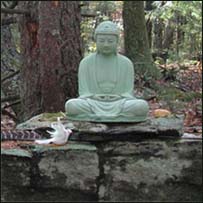|
|
 |
Please support Dharma Seed with a 2025 year-end gift.
Your donations allow us to offer these teachings online to all.

|

|

|
The greatest gift is the
gift of the teachings
|
|

|
| |
|
Retreat Dharma Talks
|
|
Ajahn Sucitto Dhamma Retreat

|
| |
|
2018-02-24 (7 days)
Sasanarakkha Buddhist Sanctuary
|
|
| |
|
2018-02-25
Intro Sasanarakkha: Make your practice extensive, rather than intensive
62:12
|
|
Ajahn Sucitto
|
|
|
The essence of Buddhist practice is dealing with dukkha, unsatisfactoriness. While on retreat, observing precepts, making determinations and simplicity support our cultivation. So there’s always something you can be cultivating throughout the day. Meditation is just a support to Dhamma, Dhamma is the main thing. Cover it all. [40:36 Guided meditation] Settling practices, settling into space. Begins with feeling ground beneath, upright axis of spine, using wide visual field as a support.
|
|
2018-02-25
Initial Instruction - devotion, posture, breathing
56:05
|
|
Ajahn Sucitto
|
|
|
Rather than getting somewhere or accumulating anything, Dhamma practice is a matter of bringing forth from ourselves in terms of presence, faith and attention. Attention is a matter of the heart, and the heart is very much supported through the body. Mindfulness of body is the frame; with suitable posture the process of breathing can flow through naturally. [40:02 Begin standing instructions]
|
|
2018-02-26
Instruction - conscious attention
20:15
|
|
Ajahn Sucitto
|
|
|
Attention is a constant thing, so if you don’t place it, it will find its own place, and it will generally place itself into suffering – what could be, should be, things we can’t quite manage. Place it somewhere useful, starting with the body. This is the foundation. [10:03 instructions on breathing and breath energy] With good clear breath energy, mind can establish mindfulness. Careful attention prepares the ground so there’s something suitable to be mindful of. [20:10 begin silent sitting meditation]
|
|
2018-02-26
Energy, its bondage and liberation
60:44
|
|
Ajahn Sucitto
|
|
|
All living things have energy, it’s our natural vitality, but it gets programmed to be driven, compulsive, and stressful. There is possibility of withdrawing energy from activities that cause suffering, that which we do compulsively.
|
|
2018-02-26
Hold attention steady with a wide visual field
42:39
|
|
Ajahn Sucitto
|
|
|
For awareness that’s not fully awakened or grounded, there are bound to be reactions, so ideally we place our attention on simple forms that have least reactivity as possible.. Practice with a wide visual field, placing attention on the frame rather than objects within the frame.
|
|
2018-02-26
Maturation of the liberated mind
49:16
|
|
Ajahn Sucitto
|
|
|
Reading from AN9.3, Ajahn Sucitto reviews the 5 things that lead to maturation of mind to becoming completely liberated. Receiving supportive company runs throughout. It’s not something we do but something we associate with. It involves not the active aspect of energy but the receptive aspect, so we can absorb the skilful, give it time to settle and ripen so wisdom can arise.
|
|
2018-02-27
Careful Non-differentiation
57:52
|
|
Ajahn Sucitto
|
|
|
The process of meditation is one of reducing differentiation/proliferation, the movements of the mind towards the pleasant and away from the unpleasant. The body doesn’t proliferate and so can help calm the mind.
|
|
2018-02-27
Guided mindfulness of breathing
34:51
|
|
Ajahn Sucitto
|
|
|
Breathing itself trains you, you don’t train it. It trains you to be patient with it, open to it, sensitive to it, stay with it. Balance the doing and allowing, they both have their part to play.
|
|
2018-02-27
Q&A differentiation and discernment, tension, goodwill
46:30
|
|
Ajahn Sucitto
|
|
|
Questions are paraphrased: 1. Given the stressfulness of differentiation, is choosing what kind of meditation to practice stressful? 2. (11:30) Is the undifferentiated, the signlessness – the same as emptiness? 3. (24:02) Could you repeat what you were saying about relaxing tense muscles 4. (37:25) What does it mean to imbue the heart with loving kindness, “likewise the second, likewise the third and likewise the fourth”? What is the all encompassing world…?
|
|
|
|
|